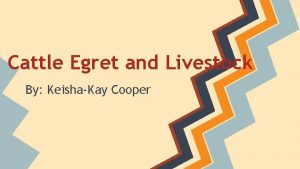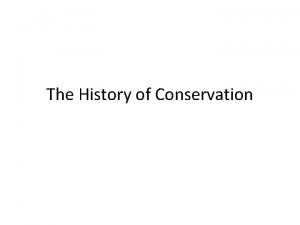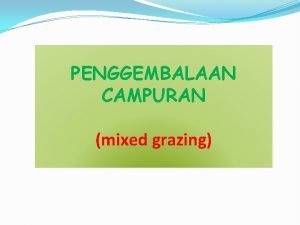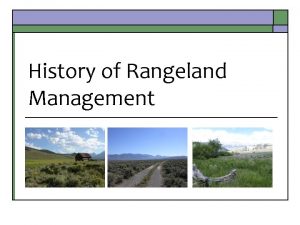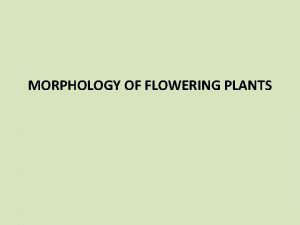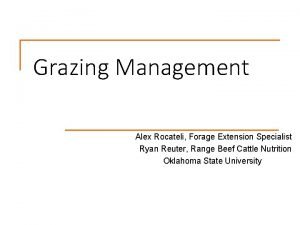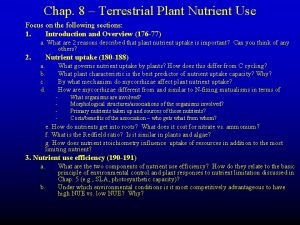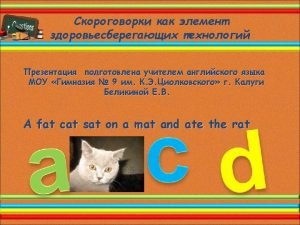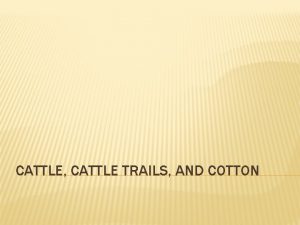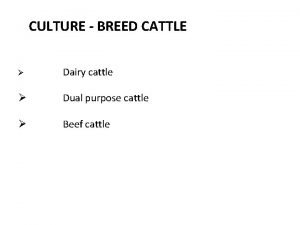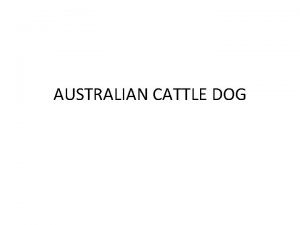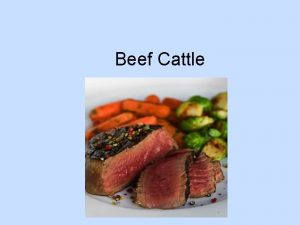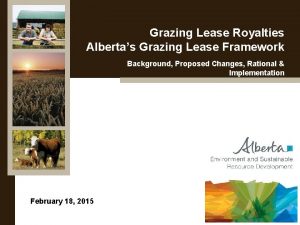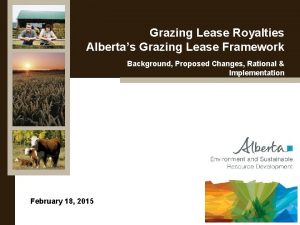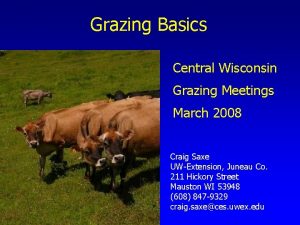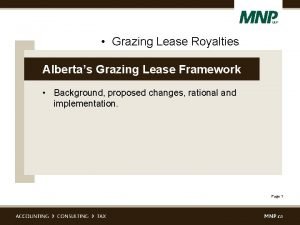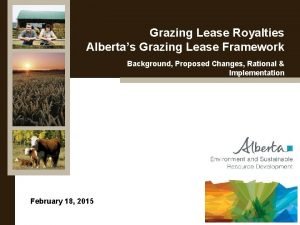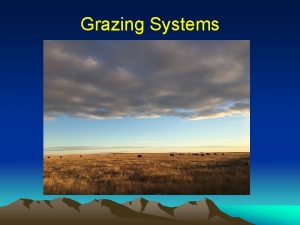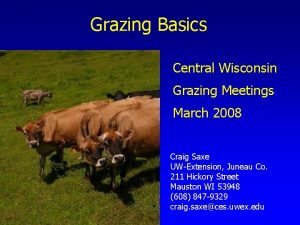Effects of Cattle Grazing and Environmental Factors on















- Slides: 15

Effects of Cattle Grazing and Environmental Factors on Seed Production in Dropseed Dominated Grasslands of the Chihuahuan Desert AMP recipient: Iris De La O Conservation Ecology Project Mentor: Martha J. Desmond NMSU, Fish, Wildlife and Conservation Ecology

Overview • • Introduction to Chihuahuan Desert Grasslands Desertification and Woody Encroachment Chihuahuan Desert Grasses and Grazing Winter Grassland Birds Problem and Importance Hypothesis and Predictions Methods Expected Outcomes

Chihuahuan Desert Grasslands • Of all the Great Plains regions, the Chihuahuan Desert is the most heat-stressed and arid system with • Historically few native ungulates therefore • Grass species evolved without heavy grazing pressure. • Dominated by two perennial grass species- tobosa (Pleuraphis mutica) and black grama (Bouteloua eriopoda ). Robb Hitchcock

Desertification and Woody Encroachment • Has dramatically altered southwest desert grasslands in the past 200 years. • Results in: – increased shrub cover – decreased canopy cover of grasses – increased resource heterogeneity • Attributed to – climatic change – fire suppression – atmospheric CO 2 concentrations – removal of native herbivores (black tailed prairie dog, pronghorn antelope – overgrazing by livestock.

Chihuahaun Desert Grasses and Grazing • Long-lived Black grama stands transition to short-lived perennials such as three awn and dropseed. • Dropseed produce abundant seed important to wintering grassland birds. • May be preferentially grazed during growing seasons for their higher forage value during this period • Livestock have influenced grass distribution, diversity and abundance.

Chihuahuan Desert Grasses and Grazing • Methods (most common) – Year-round contiguous – Best-pasture system • Intensity – the percent use of palatable forage by the forage species • 20% (light) • 40% (moderate) • 60% (high) – Guidelines for semidesert grasslands recommend 30 -40% utilization – Utilization as high as 45 -60% has occurred in this region

Winter Grassland Birds Migratory. Breed and winter different places • Entirely granivorous (eat seeds) during their non-breeding period. • Must consume seeds every 2 -5 seconds to meet metabolic needs • Abundance and distribution is strongly linked to diversity and abundance of seed resources. • Of any North American avian assemblage, grassland birds have exhibited the largest and most consistent population declines

Problem and Importance • No studies have investigated effects of cattle grazing on seed production in semi-desert grasslands. • Effects of grazing regimes and stocking densities on seed production in desert grasslands are little understood. • Seed production in relation to usual grazing regimes and recommended stocking rates must be evaluated. • Better methods of grazing management for this grassland type can be recommended. • Ensure the success and continuation of granivorous bird communities in the desert southwest.

Hypothesis and Predictions • Hypothesis: Seed production will be related to stocking rates within pastures – Prediction: Seed production will be higher on non-grazed versus grazed plots. – Prediction: A treatment effect will be observed with lower seed production on plots with moderate compared to low stocking rates. Conservation Commission of Missouri

Methods • Four pastures with two grazed and two ungrazed 25 m 2 plots each have been selected for a total of 16 plots. • Pasture selection is based on current and past stocking rates and accessibility. • An automated weather station was centrally located within each pasture. • Plant cover and species composition were estimated for each of the 16 plots using the line-intercept method (Cook and Stubbendieck 1986) during august

Methods: Seed Traps • Using the design of Pulliam and Brand (1975), twenty seed traps were evenly spaced in a 5 x 4 grid within each plot. • All traps were a minimum of 20 m from the exclosure edge • Seed traps were not set within 100 m of watering areas. • Temporary grazing enclosures made with two strands of barbed wire were established around seed traps in grazed areas once the traps had been placed, to prevent cow/calf pair disturbances.

Methods: Samples • Seed traps were emptied every 2 weeks from September 15 -January 30. • Seed samples are sorted through by hand under microscopes. • Seeds are separated and organized into individual baggies and placed in a small envelopes. • Seed sample filter and associated debris are returned to the original envelope. • Seed quantity and type are recorded on data sheets and backed up on disk.

Lab Responsibilities • Sort seed samples • Organize database • Conduct initial analysis – Grazed vs. Non-grazed • Seed Abundance • Seed Composition

Expected Outcomes • Seed production will differ between grazed and ungrazed grids, being lower on grids with moderate compared to low utilization. • Differences in seed production may be weather dependent with greater differences between treatments in moderate to wet years. Plants need rain to produce seed • As no other studies of this kind have been done, further predictions are difficult to make.

Acknowledgements • Martha J. Desmond, Associate Professor and Mentor, Fish, Wildlife and Conservation Ecology Dept. • USDA Seed Lab for help with seed identification • Elena Tsentas, Research Assistant
 Cattle egret and cattle symbiotic relationship
Cattle egret and cattle symbiotic relationship Taylor grazing act 1934
Taylor grazing act 1934 Taylor grazing act 1934
Taylor grazing act 1934 Mixed grazing
Mixed grazing Taylor grazing act 1934
Taylor grazing act 1934 Eltonian pyramid
Eltonian pyramid Taylor grazing act 1934
Taylor grazing act 1934 Protect bougainvillea from grazing animals
Protect bougainvillea from grazing animals Navajo nation grazing permit laws
Navajo nation grazing permit laws Alex rocateli
Alex rocateli Grazing food chain
Grazing food chain He that hatches matches hatches catches
He that hatches matches hatches catches Concept of ecosystem
Concept of ecosystem Crow food chain
Crow food chain Social effects of natural disasters
Social effects of natural disasters Tidal energy impact on environment
Tidal energy impact on environment
